|
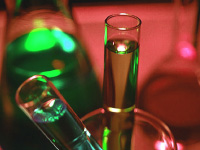 Red Dye #40 (and all FDA certified dyes)
is referred to as a "Coal Tar" dye. The phrase has
little meaning today but a hundred years ago it was used to
describe synthetic chemicals that started out with coal tar
as a precursor. It's more likely today to find a petrochemical
as the original base of most synthetic chemicals, though they're
so highly refined that you won't find any residual petroleum
in the product.
Red Dye #40 (and all FDA certified dyes)
is referred to as a "Coal Tar" dye. The phrase has
little meaning today but a hundred years ago it was used to
describe synthetic chemicals that started out with coal tar
as a precursor. It's more likely today to find a petrochemical
as the original base of most synthetic chemicals, though they're
so highly refined that you won't find any residual petroleum
in the product.
The proper chemical name for Red40 is:
6-hydroxy-5-[(2-methoxy-5-methyl-4-sulfophenyl)azo]-2-naphthalenesulfonic
acid
which is a terribly long word for a very tiny molecule. The
chemical is often referred to as an "azo" dye. If
you look at the drawing of the chemical below, you'll see
two Nitrogen atoms near the center of the molecule (passing
your cursor over the drawing will highlight the "N"
on the nitrogen atoms) The way the two Nitrogens are connected
together with a double bond is called an "azo" bond;
this is what makes this chemical a part of the "azo"
family.
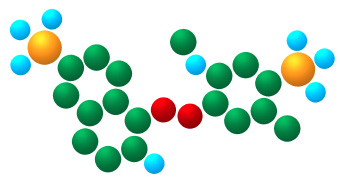
Azo dyes come in all colors, though the only
azo dyes used in food are in the red-yellow range.
There are other dyes with similar chemical
structures to that of Red 40. The closest certified color
is FD&C Yellow #6, which is extremely similar. As you
pass your mouse over the diagram below, you'll be able to
compare the two chemical structures.
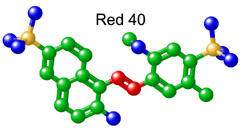
Yellow 6 is a smaller molecule than Red40
and reflects light at a slightly higher frequency. While Red40
is described as a orangish-red color, Yellow 6 is described
as a Yellowish-orange color. It's most often used to create
a pure orange color in foods - just as you'll find Red40 in
cherry and strawberry flavored foods, you'll find Yellow 6
in orange flavored foods.
Another similar dye which was recently banned
in Europe (it's not permitted in foods in the USA) is called
Sudan 1. Sudan 1 is a red dye and has a very close structure
to the certified azo dyes. Pass your mouse over the Sudan
1 molecule and you'll be able to compare the similarity to
Red40.
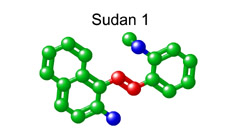
The food dye that's generated the most controversy
is Yellow Dye #5, Tatrazine. Yellow 5 has been demonstrated
to provoke an allergic reaction in some people and there are
FDA regulations that require all prescription medications
to post a notice if they are formulated with Yellow 5. (Note:
There are no similar requirements for any of the other certified
dyes in prescription medication)
Yellow 5 is also an azo dye and has quite
a few chemical similarities to Yellow 6 and Red 40.
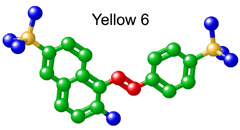
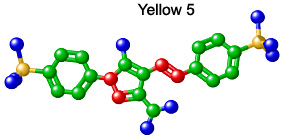
If you compare Yellow 6 and
Yellow 5, you'll see that they're identical to the right of
the azo group but Yellow 5 substitutes a Pyrazole for a Benzene
ring on the left side of the molecule. This structure moves
the reflected light to an even higher frequency than Yellow
6, producing a pure lemon-yellow color.
There are many, many other azo dyes similar
to the three mentioned here but they are not certified for
use in foods. Most commonly they'll be found in papers, textiles,
plastics and other non-biological uses where bright color
and stability are desired.
Lakes
Often on a label you'll see a color listed
as a lake, i.e.: "FD&C Red #40 Lake"
or "Blue 1 Lake" So what's a lake? Most of
the dyes in use are water soluble, which is wonderful if you're
coloring a juice or syrup. It becomes a bit of a problem if
you're trying to color the outside of a medicine tablet. The
manufacturer doesn't want the color to run off if the pill
gets a little wet. The answer is to use a dye in a lake form.
A lake is a solid, non water soluble form
of a dye. It's produced by mixing the dye with Aluminum Hydroxide.
By itself Aluminum Hydroxide is a safe food ingredient and
it's often sold as an antacid. When combined with Red Dye
#40, the chemicals form a deep red powder that can be applied
to the outsides of tablets, gumballs and other solids. You
may also notice this form listed in the ingredients as "Red
40 Aluminum Lake"
|
